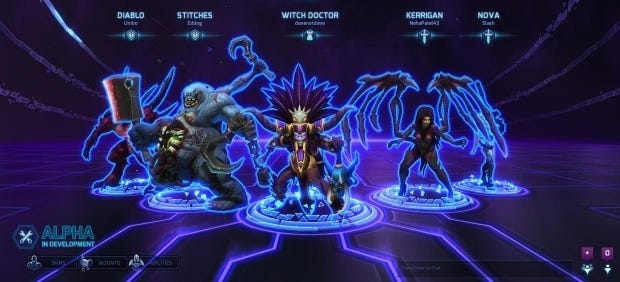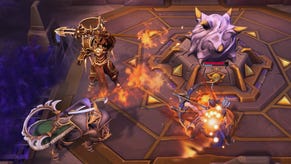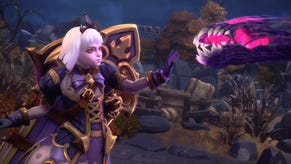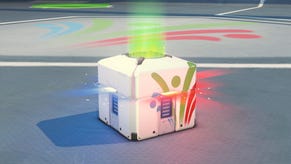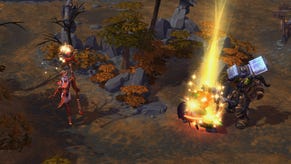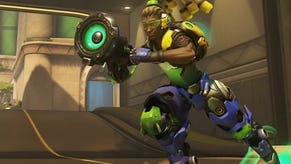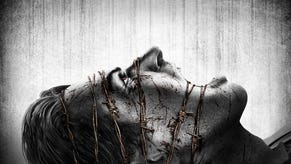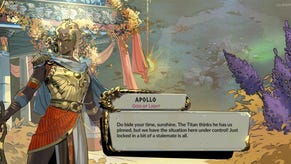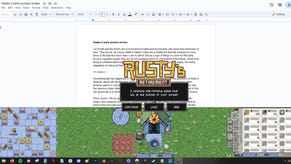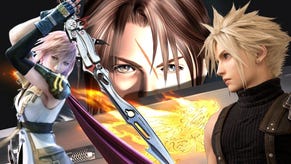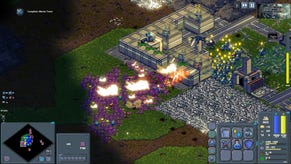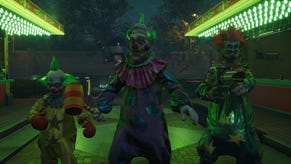Hands On: Heroes Of The Storm
HotS Stuff
'Hero brawler'. That's what Blizzard would like you to call their all-star lane pushing videogame, Heroes of the Storm. In marketing terms it's better than referencing your competitors by saying Dota-like or LoL-a-like (sidenote: no-one says LoL-a-like and this is a crying shame). More importantly, it's better than the emotionally dead and uselessly expansive MOBA. It gives you the flavour of the game you're about to play. The phrase 'hero brawler' contains something of the rambunctiousness you'll find infecting lanes, infiltrating the weird scrubland that the genre's traditional vocabulary dubs 'jungle' and venturing into haunted mineshafts.
The game sees you pick a hero from the Blizzard-iverse (that's also not a term people use but slightly more understandably than LoL-a-like) and engage in a 5v5 magic punch up. It's the same basic format you'll find in Dota 2, or League of Legends or SMITE but just in case those games haven't crossed your radar, here's the basic thrust:
You shove your way down the three lanes that lead from your base to the enemy's. On the way there are buildings, heroes and little minions all of whom are trying to hold you off or push you back the way you came. Eventually one side manages to do enough shoving that they get to the other team's base and finds and destroys their amazing mystical doodad. In Dota this doodad is either a giant marble made of lava or a twinkly bonsai tree. In SMITE it's a slayable pet giant. In LoL it's a building called a Nexus. For Heroes of the Storm it's a palace.
'Why the hell am I trying to knock over a palace?' you might wonder. StarCraft's Jim Raynor wonders much the same during the tutorial and is told by tutorial-giver Uther not to think about it too hard. Without wanting to sound like an elitest jackass, that's the phrase which seems to underpin the whole game. Heroes of the Storm is in technical alpha at the moment so there's plenty of scope for tweaking, rebalancing and goodness knows what. What is unlikely to change is that the emphasis here is on allowing people to dive in and have fun without getting overwhelmed by the stats, facts and items which usually litter the genre.
You pick a character who looks cool and whose description gives you an idea of their role and difficulty, then you get to play them. I picked Stitches because my idea of cool is having a gaping maw in my tummy and looking completely ridiculous atop a steed. This approach to being cool is also why I find it useful to have a Hook ability to yank potential friends back towards me as they flee. The game as it stands doesn't require you to look at an enemy team and try to counter-pick any hero selection, nor does it demand you balance a lineup yourself if playing solo, although you can try to if playing as a group. Once you're in-game your hero has immediate access to all their core skills bar their ultimate ability. As you level up you'll adapt your hero to the specifics of the match by picking from selections of talent upgrades which are all pretty easy to understand.
The same desire for accessibility also means no items. In other corners of the genre buying the right item at the right time can give your character an edge, adding mobility, building magic resistance, giving health regen - whatever you need. But with so many options it's often easier to dick it up than to achieve optimal retail success, especially as a newcomer. Heroes of the Storm deals with this by taking items out of the equation entirely and making your main question 'how many people and buildings are on this bit of the board and how can I change that number so it works in my favour?'
If you're playing as red and you see there are more blue units on a lane you can expect that the lane push into your territory and start threatening your little protective forts. This is a Bad Thing. But wait! There are ways to redress the balance. The most basic is scooting up there yourself to add more heroes to the brawl. "Hello, my name is Stitches. You killed my Lich King. Prepare to die."
If you're not sure you can make good on those threats you can head into the jungle to beat up mercenary camps. Smacking them enough will recruit them to fight for your side and they waddle off to the nearest lane in order to punch foes and buildings. Useful for keeping other lanes pushed while you deal with trouble elsewhere or for stacking the odds in your current fighting area. Alternatively you can just use the opportunity to apply pressure on another lane. "Hello, my name is Stitches," you say. "You killed my Lich King. Prepare to not see me at all on account of me staying on the other side of the map and trying to chow down on this here tower which seems like a safer option, all things considered. Maybe try not to notice that I'm doing that until it's too late and I'm galloping away at speed too, cheers."
The map itself feels smaller than other MOBA maps (although that might be due to speedier travel when using mounts) so however you decide to tackle the problem you'll be able to get where you're needed quickly. More skillful players can obviously build their heroes more efficiently, make optimal use of ability combinations and position their characters to deal maximum damage while staying out of harm's way themselves. They will end up with an advantage as a result. But in my time with the game, the key to victory was mainly in keeping an eye on the ebbs and flows of bodies around the map and applying more people-volume where you wanted to push. It's not skill-less by any means but it doesn't require such an in-depth knowledge of all the mechanics at play at any given time.
I think this body-watch approach is due in no small part to the game's leveling system. Each member of your team contributes to a shared XP pot. Individual contributions will vary but the entire team will always be the same level. As a result you don't get characters who snowball and can take entire teams down on their own, nor do you end up with underleveled weaklings who can be targeted for easy gains. The difference in levels between teams didn't tend to be more than two or three in my games so the easiest way to stack the odds in our favour was with the more bodies approach. Well, more bodies or the map rewards.
Each map will have a map-specific reward which offers one side a boost. There are haunted mines where you can collect skulls in order to raise a golem to fight for you. There's a Dragon Knight your team can resurrect and use to smash up enemy buildings and punt heroes into the air. There are doubloons to collect for a pirate captain so he'll train his ship's cannons onto enemy buildings. One map even offers to curse the enemy team if you collect enough tributes, reducing their minions' health and causing their towers to stop firing.
These objectives can be entertaining interruptions to the laning tug-of-war. They're also a way to tap into a different type of tactical thinking which might come more naturally to non-MOBA players. You'll need to work out how to protect teammates who are smashing money chests or paying ghostly pirates. If you want to go questing for skulls in a separate underground zone you'll need to figure out how to keep lanes pushed out -- perhaps making use of the mercenary camps or dividing up your team.
The system is not always great though. I found myself preferring the Dragon Shire objective because it requires your team to capture and hold two points on the map while a hero from your team stands at a third point to become the aforementioned dragon knight. The dragon knight is a pretty powerful unit and you can use him to pummel the enemy forts which guard the way to their palace. The transformation only lasts a few minutes and can be ended earlier by defeating the knight, at which point the player reverts to their usual hero form. At all points your team is being asked to think about what they're doing, to work together and to choose their targets.
By contrast, in Blackheart's Bay the reward for collecting coins and delivering them safely is that cannons will be trained on the enemy buildings. They do a great deal of damage which is lovely but it means that only the initial part of the challenge is about choices you make in the game. The way the cannons apply damage directly to structures means that the player ceases to be part of that action. You're not aiming and firing the cannons, nor even selecting the targets. You are simply not involved. When your team gets a few of these cannon rewards in a row it's harder to feel ownership of a victory that comes on the back of them. When you're on the receiving end, your loss can feel bullshit.
I think the biggest problem I have with Heroes of the Storm as a whole relates to the Blackheart reward in particular. The game is fun, it's hard to fuck it up too badly, and I didn't feel any of the "OH GOD WHAT DOES ALL THIS TEXT MEAN WHAT ARE THESE ITEMS WHY AM I DEAD" dread which traditionally accompanies my first match with a new hero in a new game. But these benefits are largely related to the way the game tries to negate ego and come with disadvantages.
The team levelling sees XP being shared across the whole team. As I said earlier it means particular characters can't snowball and that less skilled players won't find themselves getting more and more irrelevant and killable as time goes on. It also means that skill doesn't have a direct correlation with individual XP. The lows are less catastrophic which is good for newcomers or players who want to just run around as their favoured Blizzard character. But the highs which come from excelling are less euphoric. When you're doing well your own leveling is slowed and skewed downward by the other players on your team.
I've been at both ends of that XP contribution spectrum and both times found it hard not to feel either constricted or slightly detached from the game. I wanted to feel like my contribution mattered and sometimes that didn't happen. The feeling has less of a chance to build as the games run to about 20-25 minutes rather than the 45-plus you can spend in Dota but it was still a sour note. The lack of in-game chat doesn't make it easier either. I felt far more connected when playing with a friend as we talked on Skype and co-ordinated attacks and used ability combinations, both of which we wouldn't have been able to do using in-game text or map pings.
An unexpected positive takeaway from the experience involved the aforementioned Warcraft character, Stitches. To give him a proper explanation beyond "I think he's cool", he's a melee warrior who can hook opponents toward him from far away. He can also slam down a cone of damage, leave a trail of putrid bile in his wake or imprison an enemy in his stomach and wander off with them for a few seconds like some gross compulsory monster taxi. He's not a million miles away from Dota 2's Pudge, a character I've always been interested in but had never tried given I usually play different roles.
Having taken Stitches for a spin a few times in HotS and had an excellent time I booted up Dota and insta-picked Pudge. After 45 minutes of being flamed by a particularly angry Bloodseeker we had scored a win and I had more kills than deaths to my name. It wasn't the best Dota I've ever played and is probably not the result Blizzard was hoping for, but feeling able to try something new was the direct result of trying similar skills out in a more experimental-friendly atmosphere.
Blizzard is trying to build a game that's fun and accessible but that isn't devoid of tactical thinking. It's as if they've taken the Olympic-sized swimming pool which is your hardcore MOBA, shrunk it to half the size and lobbed in a blow-up tropical island, a bunch of floaty toys and a water slide. It's never going to give you a purist swimming experience. That would be silly - you'd bash into all manner of weird flotsam. You're far better off working out where to stand in order to shove someone else off said island and produce the most satisfying sploosh.
Judging by snippets from the in-game global chat Blizzard will have their work cut out in terms of messaging this concept, particularly to players used to Dota, LoL and their brethren. But at least they're experimenting and it's a genre which will benefit from the variety.
